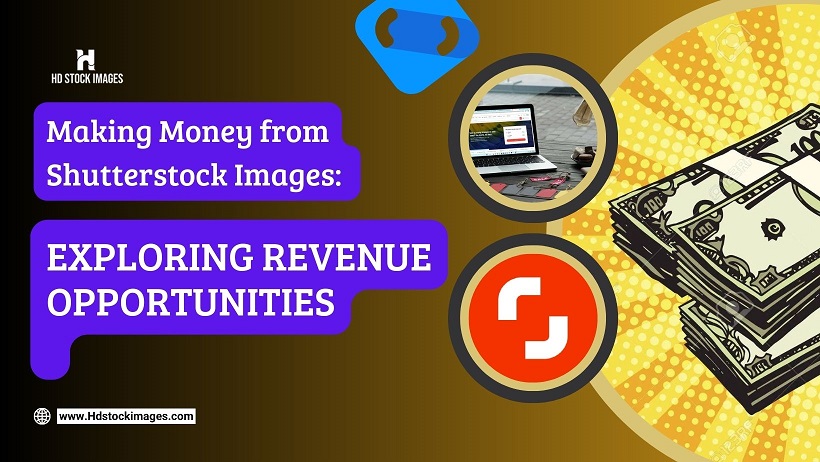1. Introduction
In today's digital age, the demand for high-quality images is skyrocketing, and platforms like Shutterstock have become go-to sources for photographers and content creators to showcase and sell their work. With millions of users worldwide, Shutterstock offers a vast marketplace for licensed images, attracting a diverse range of customers, from bloggers and marketers to graphic designers and media professionals.However, beyond simply uploading images and hoping for sales, it's crucial for photographers to explore various revenue opportunities and maximize their earnings from Shutterstock. By understanding the intricacies of the platform's licensing model and implementing effective strategies, photographers can unlock the potential to generate a steady income from their Shutterstock images.Also Read This: Understanding Why Adobe Stock Images Have Watermarks
2. Understanding Shutterstock's Licensing Model
 Shutterstock operates on a licensing model that allows customers to legally use images for their specific needs while providing photographers with the opportunity to earn royalties from their work. It's essential to have a clear understanding of this licensing model to make informed decisions and maximize your earnings on the platform.Shutterstock offers two main types of licenses: Royalty-Free and Editorial. Royalty-Free licenses are the most common and versatile, allowing customers to use images for various purposes without restrictions on usage duration or geographic location. These licenses offer a one-time payment to photographers based on image downloads.On the other hand, Editorial licenses are specifically designed for newsworthy or editorial content. They are used when images contain recognizable people, trademarked logos, or copyrighted landmarks, where commercial use may not be allowed without proper releases. Editorial images are typically used for journalistic or informational purposes.To ensure compliance with licensing requirements, Shutterstock has a review process that examines uploaded images for quality and suitability. It's crucial to familiarize yourself with the platform's guidelines and standards to increase the chances of your images being accepted.By understanding the distinctions between Royalty-Free and Editorial licenses and adhering to the licensing guidelines, you can effectively navigate the licensing model on Shutterstock and capitalize on the revenue opportunities it presents.
Shutterstock operates on a licensing model that allows customers to legally use images for their specific needs while providing photographers with the opportunity to earn royalties from their work. It's essential to have a clear understanding of this licensing model to make informed decisions and maximize your earnings on the platform.Shutterstock offers two main types of licenses: Royalty-Free and Editorial. Royalty-Free licenses are the most common and versatile, allowing customers to use images for various purposes without restrictions on usage duration or geographic location. These licenses offer a one-time payment to photographers based on image downloads.On the other hand, Editorial licenses are specifically designed for newsworthy or editorial content. They are used when images contain recognizable people, trademarked logos, or copyrighted landmarks, where commercial use may not be allowed without proper releases. Editorial images are typically used for journalistic or informational purposes.To ensure compliance with licensing requirements, Shutterstock has a review process that examines uploaded images for quality and suitability. It's crucial to familiarize yourself with the platform's guidelines and standards to increase the chances of your images being accepted.By understanding the distinctions between Royalty-Free and Editorial licenses and adhering to the licensing guidelines, you can effectively navigate the licensing model on Shutterstock and capitalize on the revenue opportunities it presents.Also Read This: How to View Your Adobe Stock Purchase
3. Maximizing Earnings from Shutterstock Images
 To maximize your earnings from Shutterstock images, it's important to adopt strategies that enhance the marketability and visibility of your portfolio. Here are some key factors to consider:
To maximize your earnings from Shutterstock images, it's important to adopt strategies that enhance the marketability and visibility of your portfolio. Here are some key factors to consider:A. Capturing high-quality, marketable images:
Identify popular themes and subjects: Research current trends and popular topics in the visual content industry. Understand the demands of Shutterstock's customer base and capture images that align with those interests.Pay attention to technical aspects: Ensure your images are technically sound with proper lighting, composition, and focus. High-quality images have a better chance of attracting customers and generating sales.B. Keywording and metadata optimization:
Use accurate and descriptive keywords: Utilize relevant keywords that describe the content, subject, and concept of your images. Think from a customer's perspective and anticipate the search terms they might use.Utilize tags and categories effectively: Assign appropriate tags and categories to your images to improve their discoverability within Shutterstock's search algorithms.C. Building a diverse and comprehensive portfolio:
Expand image variety: Aim to capture a wide range of subjects, styles, and concepts. By diversifying your portfolio, you increase the chances of appealing to a broader audience.Balance quantity and quality: While it's important to have a substantial portfolio, prioritize quality over quantity. Focus on consistently producing high-quality images that stand out among the competition.Also Read This: Grow Your Behance Profile with Effective Tips for Expanding Your Creative Network and Audience
4. Exploring Additional Revenue Streams
While earning royalties from image downloads is the primary revenue stream on Shutterstock, there are other opportunities to explore for generating additional income. Here are some avenues to consider:A. Leveraging Shutterstock's referral program:
Benefits of referring others: Take advantage of Shutterstock's referral program by referring other photographers or customers to the platform. When they sign up and make purchases or contribute images, you can earn referral bonuses or commissions.Promote your referral links: Share your referral links on social media, photography forums, or your personal website to reach a wider audience and increase your chances of earning referral rewards.B. Participating in Shutterstock's Custom Work program:
Collaborate with clients: Shutterstock offers a Custom Work program where clients can request specific images to meet their unique needs. By participating in these projects, you can generate additional income through customized assignments.Tailor your skills to client demands: Keep an eye on client briefs and requirements and align your photography style and skills accordingly. This increases your chances of being selected for custom projects.C. Licensing images for other purposes:
Explore opportunities beyond Shutterstock: While Shutterstock is a prominent platform, consider licensing your images for other purposes as well. This could involve selling prints, licensing for commercial campaigns, or offering images for use in books, magazines, or advertisements.Identify potential clients and platforms: Research potential clients, agencies, and platforms that may be interested in licensing your images. Approach them with a professional portfolio and licensing proposals to explore new revenue streams.By diversifying your revenue streams beyond standard image licensing, you can enhance your income potential as a Shutterstock contributor. The referral program, custom work assignments, and image licensing for other purposes open doors to new opportunities and expand your reach in the creative industry. Embrace these avenues to maximize your earnings and establish multiple streams of income from your Shutterstock images.WOW Football Association has awarded @Silverhubmedia & @Shutterstock exclusive multi-year agreement to cover photography & syndication services around all @FA & Wembley Stadium Events thought to be worth $5 million to $25 annually to SilverHub/Shutterstock revenue stream. pic.twitter.com/ZfSzcbQHeb
— Dazeley (@PETERDAZELEY) March 19, 2018

 admin
admin








